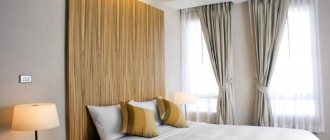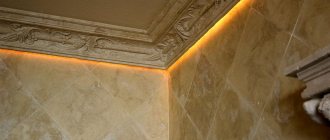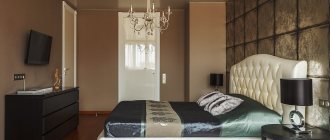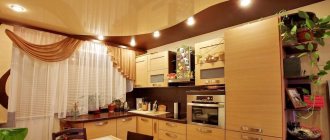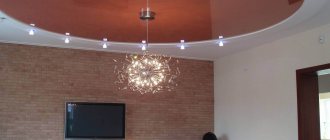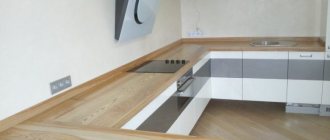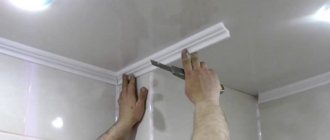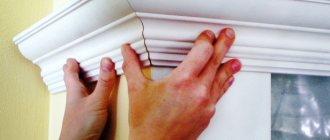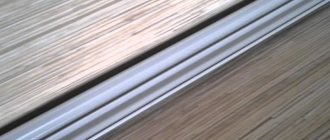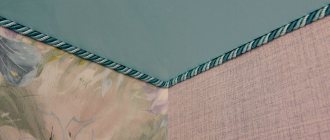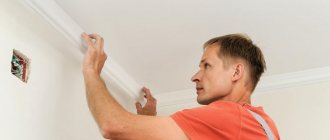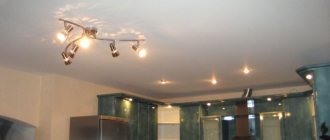Stretch ceilings are structures that are actively used for arranging the ceiling surface in many homes. They have an attractive appearance. They are characterized by simplicity, straight lines, and various variations to suit every taste. There are options for the budget and more expensive segment of buyers. Everyone can choose something suitable for themselves.
Today, stretch ceilings are the most preferred finishing option.
Skirting for a stretch ceiling is one of the accessories that perfectly complements the overall picture. This element performs not only a decorative function. It is necessary for the most rational use of the coating, as well as protection from damage. However, not all cases require the use of skirting boards. Below we will consider the use of fillets for suspended ceilings, as well as their main features and advantages.
Properly selected skirting boards play an important role in a beautiful coating.
Do you need a plinth for a stretch ceiling?
To solve this issue, you need to know what suspended ceilings are made of. They usually consist of thin PVC film, which is not very dense. The material is very light and thin.
Ceiling plinth is an important detail, which is an integral part of a beautiful and neat stretch ceiling.
A metal frame is used as fastening. It is installed around the entire perimeter of the room. Usually takes about three or four centimeters from the main height of the walls. These baguettes are tightly secured with putty. The entire structure needs reliable fastening, so it is fixed with a spatula. A special element is used to secure the fabric film.
Such elements perform several tasks, which distinguishes them from ordinary plugs between the ceiling and the ceiling.
Note! After finishing the work, small holes remain in the grooves. Dust usually accumulates in them. To hide this element, as well as to avoid excess dirt, a plinth is used. This is an excellent decorative element that hides the edges of the canvas and also protects against the formation of dust.
Many also use traditional elements. This is especially required in the classical style direction. The plinth gives a more solid appearance compared to the tape. But the choice is up to the owners - they are free to use the material they like best.
Moldings perfectly mask the gaps that appear between the stretch film or fabric and the surface of the walls.
These designs are made to imitate other natural materials. For example, there are products that look like wood or stucco. A large number of different textures, patterns, and colors are offered. Also in some cases it is possible to use built-in lighting fixtures. This especially looks harmonious in a modern style.
Thanks to these elements, the interior looks much neater and more aesthetically pleasing, and the ceiling decoration itself takes on a complete look.
Note! The fillets do not need to be glued directly to the tension structure. This can make the structure heavier, causing a collapse. The canvases usually do not have sufficient density and strength to install additional structures.
You should also choose your adhesive carefully. Some compounds can damage the surface of a stretch ceiling. It is best to choose lightweight models of borders - then they will become an excellent addition to the interior, and will also last for many years until the next renovation with proper care.
With the help of correctly selected skirting boards, you can emphasize a particular style of the existing interior.
Is it possible to leave the ceiling without a plinth?
Of course, there is no need to necessarily use a plinth to arrange a stretch ceiling structure. The choice is up to the owners. If you leave the gap untreated after installation, you can save some money on building materials. In this case, you should pay attention to the main disadvantages of such a solution:
- Unaesthetic appearance. This drawback will be especially noticeable in the corners. In such cases, you should not glue heavy and dense wallpaper. They will only make the interior heavier, making it impossible to stay indoors.
- A large amount of dust will accumulate between the ceiling and the tension structure. This will cause problems with cleaning and ongoing maintenance.
Today in stores you can find ceiling skirting boards in a variety of colors and designs.
In this case, it is better to purchase a plinth and install it. It is better not to leave gaps open, as this has an unattractive appearance.
Note! To avoid the problem, some use designs without gaps. This option is possible, but it will cost a little more.
These can be simple options that have a laconic appearance, or quite original products that resemble a luxurious baguette.
Such designs are dense baguettes with clamps. They are intended for fixing the structure to the joints of the wall. This element is almost invisible to the naked eye. It looks elegant and simple, which will fit perfectly into a minimalist interior design.
Despite the small size and discreet features, these details are the finishing touches of the interior, so it is better not to leave the suspended ceiling without them.
Important! To install a structure without gaps, you will need to perfectly level the surface of the walls. Carry out the appropriate work in advance if necessary.
Skirting boards are often used for both traditional ceilings and more modern solutions. It all depends on various factors. When choosing a suitable product, many parameters should be taken into account, as well as the total cost of the project.
A special feature of ceiling plinths is their flexible structure.
Pipe fittings
If there are pipes in the room, the question invariably arises: “How to bypass the pipe when installing a stretch ceiling?” For a more accurate installation of the tension fabric, bends are used - plates of the required diameter with a cut. The diameter of the plate should be slightly larger than the diameter of the pipe. Before stretching the canvas, the ring should be glued to the canvas from the inside and a hole should be cut inside it. The pipe is inserted into the ring.
Pipe lines
To make the appearance more attractive, sometimes such a plate is installed on the canvas from the outside.
Bypassing pipes, columns and supports
Purpose of ceiling fillets
Various types of ceiling plinths for suspended ceilings perform several functions. The lack of any processing is very noticeable and also gives a feeling of incompleteness. The presence of a plinth will be an excellent finishing touch and will also fit perfectly into any interior.
As a rule, these parts are made from light and pliable materials - PVC, polystyrene foam and polyurethane foam.
The presence of finishing is mandatory if you want to draw attention to your room or make an accent. In this case, you should choose products that properly perform their functions. Otherwise, there is no need to spend extra money on useless items.
Lovers of luxurious and pompous interiors will definitely appreciate beautiful skirting boards with stucco molding.
The border allows you to hide the gap between the stretch ceiling structure and the wall. This helps to significantly simplify the maintenance of the entire structure throughout its service life.
Using ceiling plinth, you can achieve the following results:
- Set a specific style of execution that complements the overall design of the room.
- Become the final element of the composition.
- Hiding the gap where dirt and dust accumulate.
- Possibility of installing an additional lighting system that gives a certain effect.
Another feature of ceiling skirting boards is their ability to hide small unevenness in the base.
Using an exquisite composition, you can complement even the most boring composition. Then the ceiling will become a stylish modern component.
A distinctive feature of suspended ceiling strips is their low weight.
Before you start work, you should consider some nuances. Remember that the structure is attached directly to the wall, not to the canvas. Light panels can be attached directly to the wallpaper, and heavy panels can be attached using self-tapping screws to special joints.
Decoration of corners
Self-finishing of corner joints of skirting boards is carried out as follows:
- You need to take two skirting boards adjacent in texture and mark with a pencil the area where the joint will be located.
- Using a miter box, the edge of one of the plinths is cut at 45 degrees at a short distance from the intended point.
- Then all the other skirting boards are cut in pairs. When cutting, you must remember that the corners of the parts must ultimately align.
Problems may arise with skirting boards that have a complex pattern, so you need to buy them with a small margin for trimming. If the installation of the plinth is planned not near the wall, but at a strictly defined height, then each individual part must be cut individually, taking into account the characteristics of the place of its installation.
What are the types of borders for suspended ceilings?
There are many different types of skirting boards for tension structures. Let's look at some of them:
- Rubber molding. One of the popular and expensive decorative design elements. The length of such a product reaches two and a half meters. Available in only one color – white. No glue is used to install them. Attached using special grooves.
- Flexible baseboard. Such a product is selected based on the base material. Their texture should match completely. The element is practically invisible on the surface. Completely merges with the main canvas. Usually sold in sets.
- Decorative insert. This system allows you to hide various shortcomings. At the same time, it has high aesthetic properties. These elements are distinguished by flexibility, lightness, various design forms and solutions.
They shouldn't be heavy. Otherwise, these parts will not adhere securely to the surface of the floors to which they are attached.
There is also another classification, which consists of identifying the main structural elements. Let's look at the most common of them.
From foam plastic
These are simple, economical and affordable elements that are most often used during renovation work. They are distinguished by a light design, no frills, and soft shapes.
Note! Such products are very light, so they can crumble. Care should be taken during installation of the structure.
Foam skirting boards are the most commonly used. They weigh little, are easy to cut and install.
The product must be used with the utmost care. Be sure to take all measurements before gluing. Otherwise it will be very difficult to peel off the strip. Polystyrene foam is fragile and therefore sensitive to the effects of many negative substances.
Polyurethane
This material is more profitable than the previous one. The material is durable, reliable, and flexible. It allows you to hide all the shortcomings that arose during the installation of the suspended ceiling and give it a non-standard shape, which is beneficial for uneven rooms.
Heavy large-format curtain rods must be additionally fixed with self-tapping screws.
They are used for zoning space, as well as for optimal placement of necessary elements. There are a large number of different design solutions on the market to suit every taste. It is distinguished by its relief, decorativeness, and ease of use. There are elements with colored inserts.
Please note the following material shortcomings:
- high cost compared to other similar products;
- The mass of one baguette is quite large, so you will have to glue it to the surface of the walls - for this you will have to study a special gluing technology.
Plastic
One of the most common materials. It is light in weight. Less flexible than the previous version. Suitable for rectangular or square shaped rooms. Typically used in a minimalist style.
PVC skirting boards are ideal for film ceilings, since their composition is almost identical.
Often on the market there are models that imitate wood and other natural structures. When exposed to direct sunlight, the structure turns yellow.
Guide profile – baguette
The main structural element that holds the tension fabric is a baguette . Baguettes are made from aluminum and plastic. Baguettes made of aluminum and rigid PVC are suitable for textile ceilings. They allow you to securely clamp the canvas with a clip.
Harpoon and wedge systems allow the use of any baguettes, both aluminum and plastic. They are chosen depending on the weight and size of the canvas. Aluminum baguettes are stronger and more durable, but also more expensive. Plastic baguettes are easier to attach to the surface, they are more flexible and cheaper.
Baguettes are divided into groups according to their purpose:
- Wall and ceiling profiles. Used when attaching the canvas to the wall. A variety of fastening systems require the use of various baguettes. The wall molding is attached with self-tapping screws to the wall or other vertical surface. The ceiling molding is also attached to the ceiling (horizontal surface) with self-tapping screws. The distance between the screws for plastic profiles should not exceed 10 cm, for aluminum profiles – 15-50 cm (depending on the design). It is possible to use a universal profile that is attached to both the ceiling and the wall.
- Ceiling curtain rod KP4042 is equipped with a groove for fastening the curtain. This cornice is installed tightly on the wall where the window is located, at the same level as other baguettes. The canvas is tucked into a groove located closer to the wall, the remaining grooves are provided for hanging curtains.
- Profile for level transitions. In a multi-level design, you can choose different shapes. The profile used for a single-color ceiling is called a bumper. It helps to form an even angle for the canvas and make a difference in heights. The material for the manufacture of this profile can be aluminum or plastic. The shape of the bump stop can be different.
- Z-shaped bumper. To install multi-level ceilings, which consist of different canvases, profiles of different modifications are used during level transitions. The KP 4000 aluminum profile is used for gapless level transitions. It does not require installation of plugs. It is attached to a vertical surface.
- KP 4000 for gapless level transition.
- Ceiling profile PP75 for gapless transition.
- PP 75 for gapless level transition
- The PL75 profile (similar to the PP75 profile) has a special groove into which the LED strip is fixed and covered with a diffuser insert.
- PL 75 for level transition with backlight.
Separating profile
Designed for joining panels of different textures and different colors in single-level ceilings. Based on the type of installation, these profiles are divided into horizontal and vertical. During the installation process, the blades are inserted into the corresponding grooves on both sides, and the junction of the blades is closed with a plug.
Dividing profile for harpoon system
- The corner profile is also a dividing one. It is designed for contours of both external corners and openings and columns.
- KP 4003 For floating ceilings made of translucent filmSeparating corner profile
- The separating profile KP4075 is equipped with a niche in the center into which the lighting is built in. The niche is covered with a translucent film of stretch fabric. Which creates a strip of soft light.
- KP 4075 Divider with backlight
- Installation of floating ceilings can be done using profiles of various designs and purposes: ceiling, wall, dividing, for level transitions (analogous to PL75). The material for these profiles is aluminum. To highlight the perimeter of the walls, the KP4003 wall profile is used. It is used for translucent films.
- KP 4003 For floating ceilings made of translucent film
- When using an opaque film on floating ceilings, the KP2301 profile is used, which creates a clear line along the perimeter of the walls. In this case, the LED strip, installed in a niche between the ceiling and the wall, is covered with a light-transmitting plug, the color of which determines the color of the backlight.
- KP 2301 For floating ceilings with a diffuser plug
- When installing a multi-level floating ceiling, profiles KP-2 and NP-5 are suitable, which are connected with self-tapping screws.
- KP2 and NP5 for level transitions with backlight
Profile Apply
Two-layer structures (for 3D and “starry sky” ceilings) involve the use of Apply profiles, which are produced in several modifications. They differ in the distance between the ceiling levels and the methods of fastening - to the ceiling or wall.
- The top layer is an opaque fabric, the bottom layer is a perforated or transparent fabric with a pattern. For illumination, an LED strip is sometimes installed between these layers.
- Apply 40 for the starry sky system
- Note. When choosing guides, it is important to consider their size in order to avoid installing additional devices.
Alternatives to skirting boards for ceilings
In some cases, alternative designs are installed. This is required to facilitate the design, as well as reduce the load on the ceiling. Visually it doesn’t make the impression worse.
Masking tape
Intended for use on suspended ceilings. Typically used for curved walls. Allows you to level the surface if there are discrepancies in the height of the structure. Installed between different ends of the canvas.
It can be ordered simultaneously with the stretch fabric or purchased separately.
Usually the product is ordered together with a suspended ceiling. There are options for different textures and designs. The joints are almost invisible to the human eye. It is inserted into the hole and firmly fixed. The result is a smooth surface.
Note! This is a common and inexpensive solution. This may create the impression of some incompleteness.
Decorative cord
In some cases, cords with weaving of varying degrees of density are selected. Manufactured in a single color scheme. Gold or silver designs available. In accordance with the dimension of the gap, the required diameter of the product is selected. Most often used in structures with rounded elements. Performs a decorative function. It collects dirt a lot, so it needs cleaning.
This cord looks great in combination with matte, suede or satin fabrics.
Which ceiling plinth to choose
The product must be light and perform its functions. The choice also depends on the following criteria:
- ceiling height and installation size of the tension structure;
- shape of the room;
- for rooms with high humidity, special types of products that do not absorb moisture should be used;
- possibility of installing an additional lighting system.
In search of interesting and beautiful options, you should pay attention to original skirting boards with patterns.
Note! If there are no special requirements for the operation of the room, you can choose the most ordinary skirting boards. This will significantly save money on repairs.
Selection by size, style and color
The decision of which plinth to choose for a suspended ceiling is influenced not only by personal preferences and financial capabilities. Massive stucco will look out of place in a city apartment, and the high ceiling of a spacious hall will merge with the plain walls without any contrast. Although there are no strict selection criteria, it is worth listening to the simple recommendations of designers.
When choosing the width of the fillets, they are guided by the size of the room. For ordinary city apartments with a standard height of 2.5 m, masking tapes from inconspicuous T-shaped inserts to an L-profile imitating a baseboard are perfect. In any case, it is not recommended to make the wall part wider than 40 mm. In rooms with a ceiling height of more than 2.5 m, it is better to use overhead skirting boards 50-100 mm wide. For large rooms with a distance to the ceiling of more than 3.5 m, volumetric fillets with a width of 100-150 mm or more are chosen.
The shapes of decorative inserts used in apartments do not differ in variety - they are simple planes or imitation plinths. When choosing a plinth for a spacious room, it is better to focus on shaped models or simple ornaments - this style easily fits into any interior. The same can be said about fillets for placing hidden lighting. Complex volumetric patterns are recommended for high rooms with simple design of walls and ceilings.
The choice of fillet color also greatly influences the perception of the interior as a whole. A plinth that contrasts with the walls immediately highlights any unevenness, while a plain one distracts attention from minor imperfections and visually increases the height of the room. An insert that matches the color of the ceiling fabric visually expands the room. The use of bright colors requires caution; the situation is similar with imitation wood. They try to keep stucco molding in traditionally white or cream tones.
Advice! If you have insufficient experience in decorating rooms, you should adhere to the rule: it’s better to do less than too much. By giving preference to calm tones and strict geometric shapes, it is easier to maintain balance and create a discreet but beautiful environment.
How to install a ceiling plinth on a suspended ceiling yourself
The process of installing a border is quite simple, so you can do everything yourself. To do this, you need to collect all the necessary tools and purchase materials. Before this, calculations are carried out.
Calculation of the required amount of material
It is necessary to take preliminary measurements. If there are any irregularities, protrusions or niches, you should also take extra stock for them. It is best to purchase a separate border for these components. Buy with the expectation of protrusions or possible deterioration of materials.
Such details are suitable for hiding unsightly installation seams located around the entire perimeter of the existing area.
Installation subtleties
The product can be glued both before finishing and after. The first option will allow you to easily re-stick the wallpaper in the future without dismantling the border. The second option is suitable for those who want to save time on installation.
For wallpaper
To do this, you need to purchase a special adhesive. Start pasting from any angle. Apply glue to the surface of the border. Gently press the product into the desired location. For a more secure fixation, use tape. Glue in order. Leave the structure to dry, after which it can be painted.
Baguettes with voluminous patterns look much more interesting and brighter than typical smooth options.
For plaster
This is much simpler, as it does not require special attention to the wallpaper. The gluing process is no different from the previous version. This reduces the likelihood of damage to the finish. Use plaster glue. Follow the instructions described above.
Recommendations from professionals for installing fillets
Consider these tips:
- level the walls;
- if necessary, call specialists for installation;
- do not attach the product to the ceiling;
- While working, cover the canvas with film;
- take preliminary measurements.
It is these discreet details that often serve as the finishing touch, emphasizing a particular style of furnishings.
